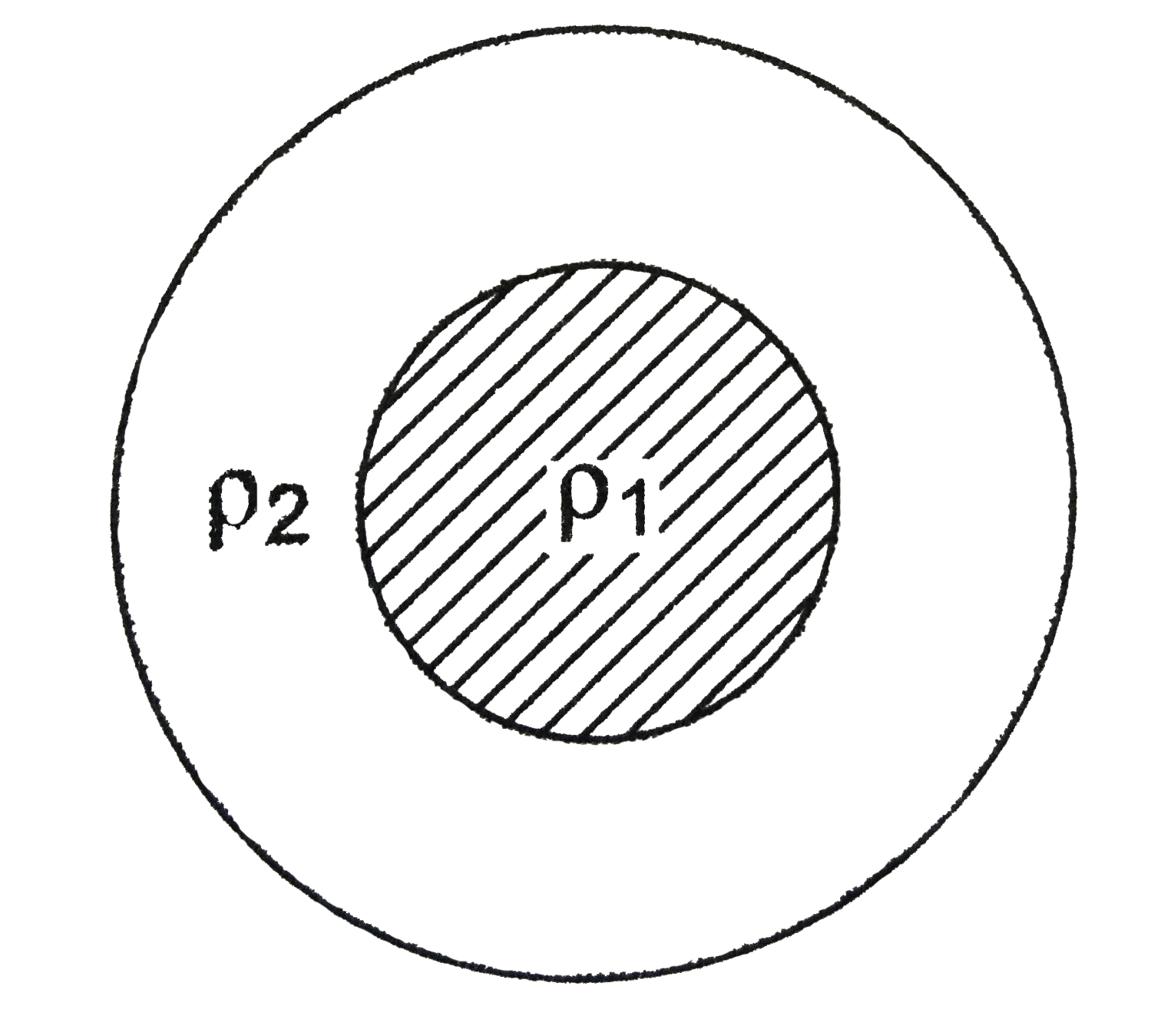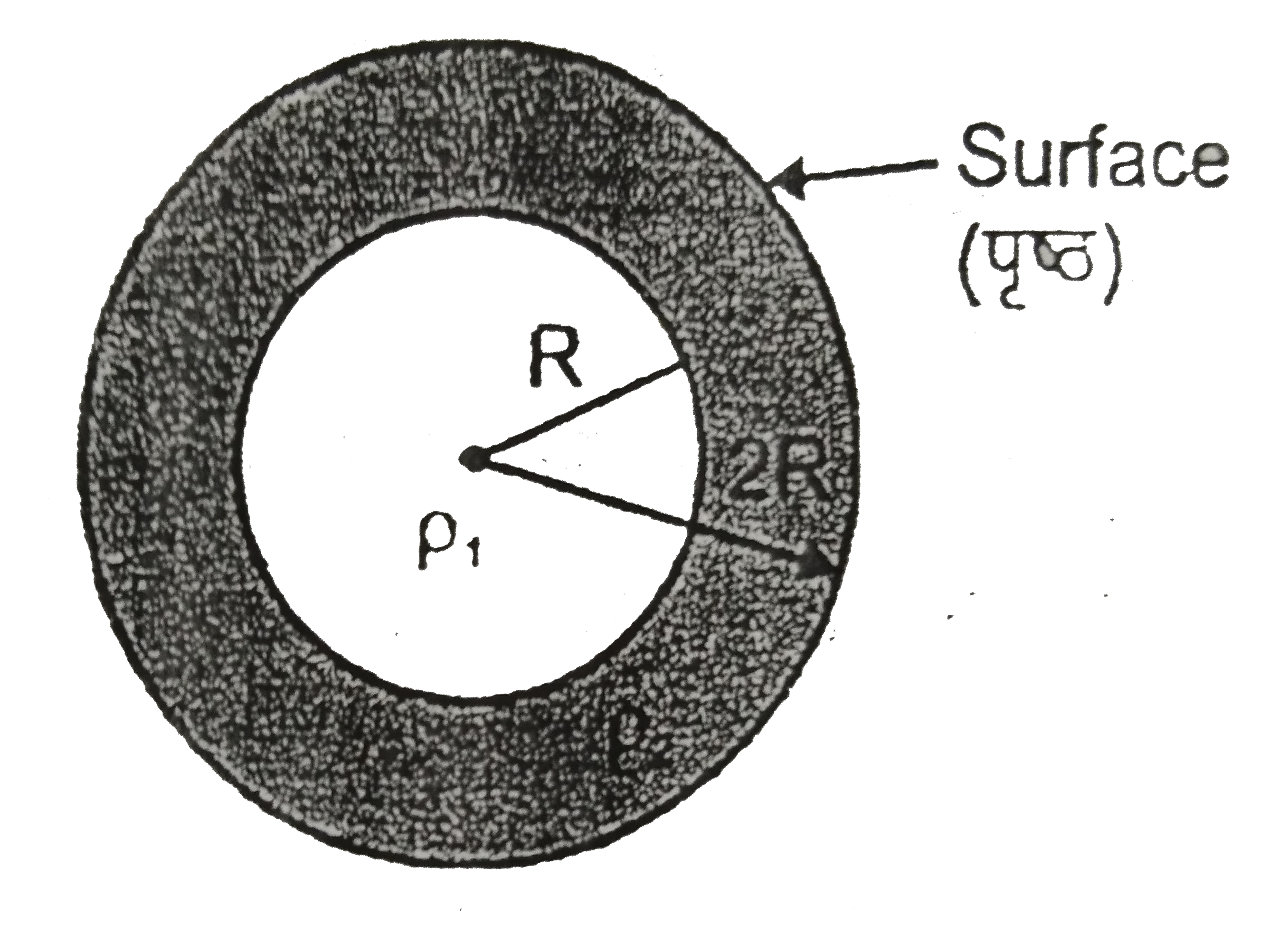The density of the core of a planet is x and that of outer shell is y. The radii of the core and that of the planet are R and 2R. The acceleration due to gravity at the surface of planet is same as at a depth R. The ratio of x and y is n/3. Find the value of n.
To solve the problem, we need to find the value of n given the conditions about the densities of the core and outer shell of a planet, and the relationship between the acceleration due to gravity at the surface and at a certain depth.
1. Understanding the Problem:
- The planet has a core with density x and an outer shell with density y.
- The radius of the core is R and the radius of the planet is 2R.
- We need to find the ratio of the densities xy given that the acceleration due to gravity at the surface of the planet is the same as at a depth R.
2. Acceleration due to Gravity at Depth R:
- The acceleration due to gravity at the surface of the planet (radius 2R) is given by:
gsurface=GM(2R)2
- Here, M is the total mass of the planet.
3. Calculating the Mass of the Planet:
- The mass of the core (radius R) is:
Mcore=density×volume=x⋅43πR3
- The mass of the outer shell (from R to 2R) is:
Mshell=y⋅(43π(2R)3−43πR3)=y⋅(43π(8R3−R3))=y⋅283πR3
- Therefore, the total mass M of the planet is:
M=Mcore+Mshell=x⋅43πR3+y⋅283πR3
4. Acceleration due to Gravity at Depth R:
- The acceleration due to gravity at depth R can be calculated using the formula:
gdepth=GMcoreR2+GMshell(2R)2
- The mass of the core contributes fully, while the mass of the shell contributes only partially (as only the mass above depth R contributes):
gdepth=G(x⋅43πR3)R2+G(y⋅43π(2R)3−y⋅43πR3)(2R)2
5. Setting the Two Accelerations Equal:
- Since gsurface=gdepth, we can set the two equations equal:
GM(2R)2=GMcoreR2+GMshell(2R)2
- Canceling G and simplifying gives us an equation to solve for x and y.
6. Solving for the Ratio xy:
- After substituting the expressions for Mcore and Mshell into the equation and simplifying, we find:
4x=x+7y
- Rearranging gives:
3x=7y⇒xy=73
7. Finding n:
- The problem states that the ratio xy=n3.
- From our calculation, we have xy=73, which implies n=7.
Final Answer:
The value of n is 7.
- The planet has a core with density x and an outer shell with density y.
- The radius of the core is R and the radius of the planet is 2R.
- We need to find the ratio of the densities xy given that the acceleration due to gravity at the surface of the planet is the same as at a depth R.
- The acceleration due to gravity at the surface of the planet (radius 2R) is given by:
gsurface=GM(2R)2
- Here, M is the total mass of the planet.
- The mass of the core (radius R) is:
Mcore=density×volume=x⋅43πR3
- The mass of the outer shell (from R to 2R) is:
Mshell=y⋅(43π(2R)3−43πR3)=y⋅(43π(8R3−R3))=y⋅283πR3
- Therefore, the total mass M of the planet is:
M=Mcore+Mshell=x⋅43πR3+y⋅283πR3
- The acceleration due to gravity at depth R can be calculated using the formula:
gdepth=GMcoreR2+GMshell(2R)2
- The mass of the core contributes fully, while the mass of the shell contributes only partially (as only the mass above depth R contributes):
gdepth=G(x⋅43πR3)R2+G(y⋅43π(2R)3−y⋅43πR3)(2R)2
- Since gsurface=gdepth, we can set the two equations equal:
GM(2R)2=GMcoreR2+GMshell(2R)2
- Canceling G and simplifying gives us an equation to solve for x and y.
- After substituting the expressions for Mcore and Mshell into the equation and simplifying, we find:
4x=x+7y
- Rearranging gives:
3x=7y⇒xy=73
- The problem states that the ratio xy=n3.
- From our calculation, we have xy=73, which implies n=7.
The value of n is 7.
Topper's Solved these Questions
Similar Questions
The density of the core a planet is ρ1 and that of the outer shell is ρ2. The radii of the core and that of the planet are R and 2R respectively. The acceleration due to gravity at the surface of the planet is same as at a depth R. Find the ratio of ρ1ρ2

View SolutionThe density of the core a planet is ρ1 and that of the outer shell is ρ2. The radii of the core and that of the planet are R and 2R respectively. The acceleration due to gravity at the surface of the planet is same as at a depth R. Find the radio of ρ1ρ2

View Solution
Knowledge Check
The density of the core a planet is ρ1 and that of the outer shell is ρ2. The radii of the core and that of the planet are R and 2R respectively. The acceleration due to gravity at the surface of the planet is same as at a depth R. Find the ratio of ρ1ρ2
 A2.3B4.5C3.2D5.4
A2.3B4.5C3.2D5.4
The acceleration due to gravity near the surface of a planet of radius R and density d is proportional to
View SolutionA planet is made of two materials of density ρ1 and ρ2 as shown in figure. The acceleration due to gravity at surface of planet is same as a depth 'R'. The ratio of ρ1ρ2 is x3. Find the value of x.

View SolutionThe acceleration due to gravity at a depth R/2 below the surface of the earth is
View SolutionThe mass and diameter of a planet have twice the value of the corresponding parameters of earth. Acceleration due to gravity on the surface of the planet is
View SolutionIf the ratio of the masses of two planets is 8 : 3 and the ratio of their diameters is 2 : 3, then what will be the ratio of their acceleration due to gravity ?
View SolutionThe time period of a simple pendulum on the surface of the Earth is T1 and that on the planet Mars is T2. If T2<T, then acceleration due to gravity on Mars is
View SolutionTwo planets have same density but different radii The acceleration due to gravity would be .
View Solution
